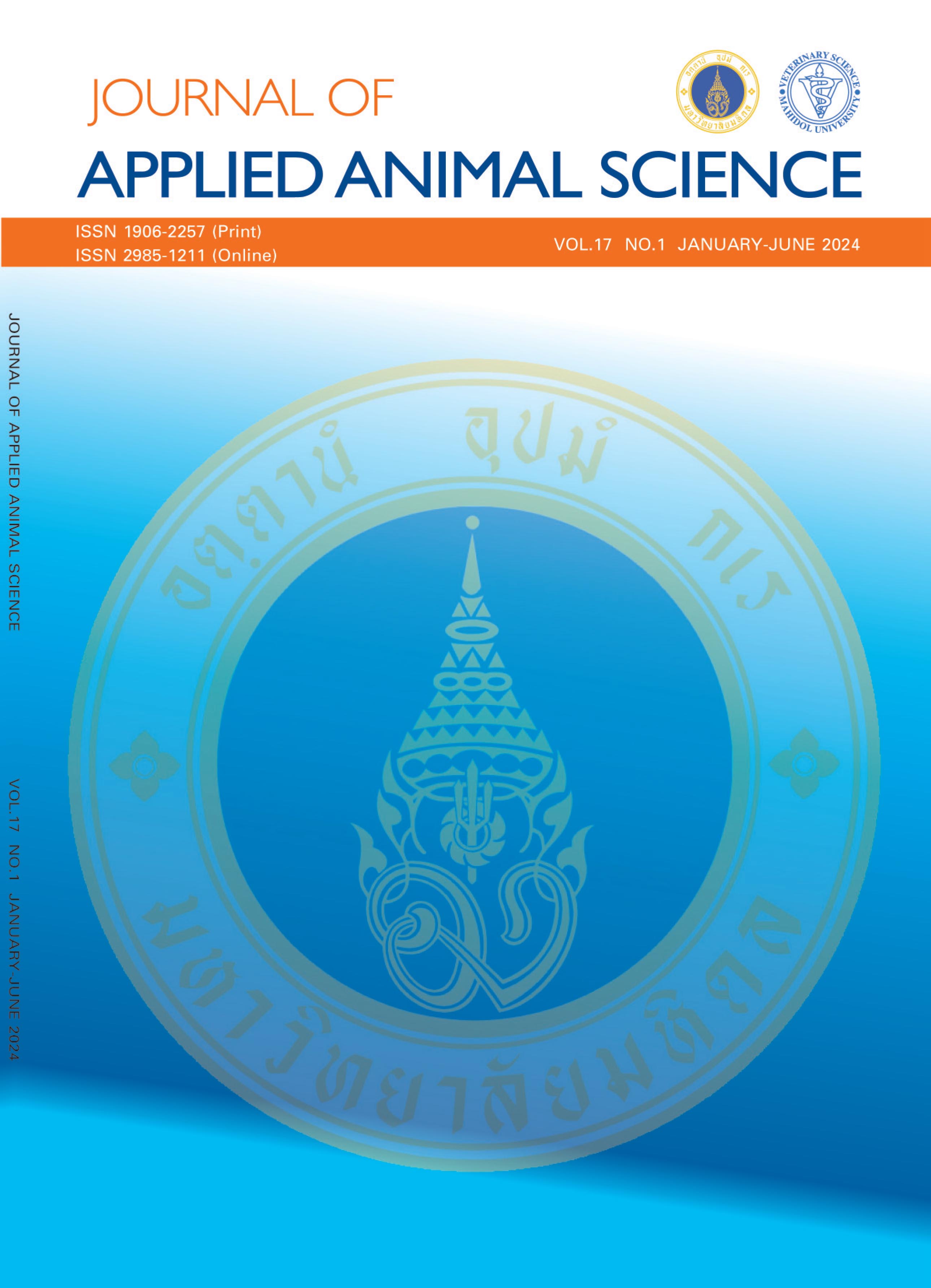Canine Intrahepatic Portosystemic Shunt in a Poodle Toy: A Case Report
Keywords:
A computerized tomography scan, Canine intrahepatic portosystemic shunt, Canine, PtyalismAbstract
An 8-month-old intact female poodle visited Prasu Arthorn Animal Hospital, Mahidol University, due to disorientation, ptyalism, and vomiting. The clinical examination revealed normal findings, except for ataxia, intermittent head shaking, and a normal pupillary light reflex with anisocoria, dazzle reflex, and threat response. Biochemical parameter measurements showed high alkaline phosphatase, ammonia, and fasting serum bile acids with a low albumin value. Ultrasonography of the abdomen showed a small liver with uniformly markedly diffuse hyperechoic parenchyma and a strange vessel coming from the intrahepatic portal vein and curving into the left part of the liver before entering the caudal vena cava. A computerized tomography (CT) scan examination confirmed a single left divisional intrahepatic portosystemic shunt (IHPSS). Based on clinical and laboratory diagnosis (hemogram and biochemistry) and CT scan examinations, portosystemic shunt (PSS) was diagnosed. Medical treatments included a hepatic formula diet and lactulose (0.5 mL/kg three times a day). A significant improvement in clinical signs was observed within a month, suggesting that medical treatments might be beneficial before considering surgical interventions for PSS. This case emphasizes the need for a collaborative approach and regular follow-up care in managing canine IHPSS, and it underscores the urgent need for further research to enhance patient outcomes.
References
Berent A, Weisse C. Portosystemic shunts and portal venous hypoplasia. Stand Care Emerg Crit Care Med. 2007;9(3):1-11.
Bunch SE, Jordan HL, Sellon RK, Cullen JM, Smith JE. Characterization of iron status in young dogs with portosystemic shunt. Am J Vet Res. 1995;56(7):853-8.
Caporali EH, Phillips H, Underwood L, Selmic LE. Risk factors for urolithiasis in dogs with congenital extrahepatic portosystemic shunts: 95 cases (1999–2013). J Am Vet Med. 2015;246(5):530-6.
Ettinger SJ, Feldman EC, Cote E. Textbook of Veterinary Internal Medicine-eBook: Textbook of Veterinary Internal Medicine-eBook. St. Louis: Elsevier health sciences; 2016.
Favier RP, de Graaf E, Corbee RJ, Kummeling A. Outcome of non-surgical dietary treatment with or without lactulose in dogs with congenital portosystemic shunts. Vet Q. 2020;40(1):108-14.
Ferrell EA, Graham JP, Hanel R, Randell S, Farese JP, Castleman WL. Simultaneous congenital and acquired extrahepatic portosystemic shunts in two dogs. Vet Radiol Ultrasound. 2003;44(1):38-42.
Greenhalgh SN, Reeve JA, Johnstone T, Goodfellow MR, Dunning MD, O'Neill EJ, et al. Long-term survival and quality of life in dogs with clinical signs associated with a congenital portosystemic shunt after surgical or medical treatment. J Am Vet Med. 2014;245(5):527-33.
Hunt G. Effect of breed on anatomy of portosystemic shunts resulting from congenital diseases in dogs and cats: a review of 242 cases. Aust Vet J. 2004;82(12):746-9.
Konstantinidis AO, Patsikas MN, Papazoglou LG, Adamama-Moraitou KK. Congenital portosystemic shunts in dogs and cats: Classification, pathophysiology, clinical presentation and diagnosis. Vet Sci. 2023;10(2):160.
Mehl ML, Kyles AE, Case JB, Kass PH, Zwingenberger A, Gregory CR. Surgical management of left‐divisional intrahepatic portosystemic shunts: outcome after partial ligation of, or ameroid ring constrictor placement on, the left hepatic vein in twenty‐eight dogs (1995–2005). Vet Surg. 2007;36(1):21-30.
Plested MJ, Zwingenberger AL, Brockman DJ, Hecht S, Secrest S, Culp WT, Drees R. Canine intrahepatic portosystemic shunt insertion into the systemic circulation is commonly through primary hepatic veins as assessed with CT angiography. Vet Radiol Ultrasound. 2020;61(5):519-30.
Proot S, Biourge V, Teske E, Rothuizen J. Soy protein isolate versus meat based low protein diet for dogs with congenital portosystemic shunts. J Vet Intern Med. 2009;23(4):794-800.
Spies K, Ogden J, Sterman A, Davidson J, Scharf V, Reyes B, et al. Clinical presentation and short‐term outcomes of dogs≥ 15 kg with extrahepatic portosystemic shunts. Vet Surg. 2024; 53(2): 277-86.
Tisdall P, Rothwell T, Hunt G, Malik R. Glomerulopathy in dogs with congenital portosystemic shunts. Aust Vet. 1996;73(2):52-4.
Van den Bossche L, Van Steenbeek F. Canine congenital portosystemic shunts: Disconnections dissected. Vet J. 2016;211:14-20.
Wakshlag JJ, Cital S, Eaton SJ, Prussin R, Hudalla C. Cannabinoid, terpene, and heavy metal analysis of 29 over-the-counter commercial veterinary hemp supplements. Veterinary Medicine: Research and Reports. 2020:45-55.
Weisse C, Berent AC, Todd K, Solomon JA, Cope C. Endovascular evaluation and treatment of intrahepatic portosystemic shunts in dogs: 100 cases (2001–2011). Am J Vet Res. 2014; 244(1):78-94.
Winkler JT, Bohling MW, Tillson DM, Wright JC, Ballagas AJ. Portosystemic shunts: diagnosis, prognosis, and treatment of 64 cases (1993–2001). J Am Anim Hosp Assoc. 2003;39(2):169-85.
Downloads
Published
How to Cite
Issue
Section
License
Copyright (c) 2024 Mahidol University Faculty of Veterinary Science

This work is licensed under a Creative Commons Attribution-NonCommercial-NoDerivatives 4.0 International License.
Published articles are under the copyright of the Journal of Applied Animal Science (JAAS) effective when the article is accepted for publication. The editorial boards claim no responsibility for the content or opinions expressed by the authors of individual articles in this journal. Partially or totally publication of an article elsewhere is possible only after the consent from the editors.



